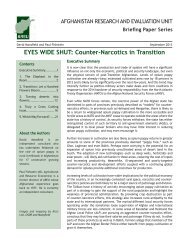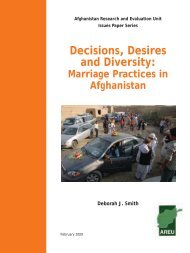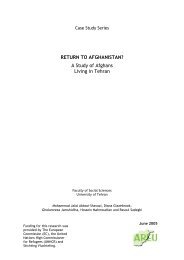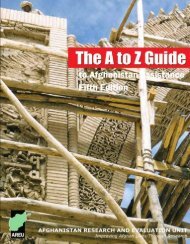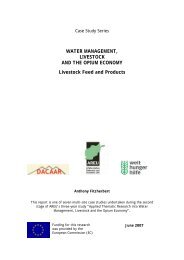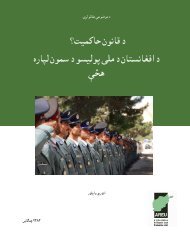Local Governance in Afghanistan: A View from the Ground
Local Governance in Afghanistan: A View from the Ground
Local Governance in Afghanistan: A View from the Ground
- No tags were found...
Create successful ePaper yourself
Turn your PDF publications into a flip-book with our unique Google optimized e-Paper software.
<strong>Afghanistan</strong> Research and Evaluation Unit<br />
2011<br />
7. Policy Implications<br />
<strong>Afghanistan</strong>’s economy, government and society have all experienced substantial changes s<strong>in</strong>ce 2001.<br />
This study has sought to explore <strong>the</strong> various forms of local governance operat<strong>in</strong>g <strong>in</strong> <strong>the</strong> six study<br />
prov<strong>in</strong>ces of Day Kuni, Jawzjan, Laghman, Samangan, Sar-i-Pul and Wardak dur<strong>in</strong>g 2010, a time when<br />
resource flows to <strong>the</strong> country were at <strong>the</strong>ir peak. Donor assistance has been particularly critical<br />
<strong>in</strong> support<strong>in</strong>g programmes orientated toward assist<strong>in</strong>g <strong>the</strong> Afghan government develop effective<br />
governance and economic structures that will provide <strong>the</strong> basis for <strong>the</strong> country’s future development.<br />
However, as <strong>the</strong> target date for <strong>the</strong> withdrawal of external military support <strong>in</strong> 2014 approaches,<br />
development fund<strong>in</strong>g is likely to decrease.<br />
Initial efforts after 2001 to reform government <strong>in</strong>stitutions focused on <strong>the</strong> development of central<br />
structures. More recently, <strong>the</strong>re has been an <strong>in</strong>creas<strong>in</strong>g focus on <strong>the</strong> need to build local government<br />
capacity and reflexive <strong>in</strong>stitutions below <strong>the</strong> central level. However, <strong>the</strong> process is long overdue,<br />
sometimes confused, and appears driven by <strong>the</strong> desire to ga<strong>in</strong> public trust and support for <strong>the</strong><br />
government ra<strong>the</strong>r than deepen representation and <strong>the</strong> democratic process. Thus, while <strong>the</strong>re<br />
has been an <strong>in</strong>creased momentum <strong>in</strong> service delivery, <strong>the</strong> address<strong>in</strong>g of local governance has been<br />
characterised by hesitancy <strong>in</strong> address<strong>in</strong>g related structural issues associated with <strong>the</strong> formation<br />
of transparent and accountable <strong>in</strong>stitutions. This has resulted <strong>in</strong> a failure to enact <strong>the</strong> legislation<br />
necessary to def<strong>in</strong>e and implement a clear policy towards <strong>the</strong> status and function of representative<br />
bodies.<br />
The aim of this research is to contribute to a better understand<strong>in</strong>g of <strong>the</strong> nature of local governance<br />
through exam<strong>in</strong><strong>in</strong>g <strong>the</strong> diversity of its operation. To compliment <strong>the</strong> many sectoral and area-specific<br />
studies that have taken place, it has sought to capture someth<strong>in</strong>g of <strong>the</strong> geographic diversity as well<br />
as <strong>the</strong> organisational complexity that characterises governance <strong>in</strong> <strong>Afghanistan</strong>. More specifically,<br />
it has had <strong>the</strong> opportunity to exam<strong>in</strong>e <strong>the</strong> nature of adm<strong>in</strong>istration, <strong>the</strong> operation of security and<br />
justice, issues of service delivery and representation. Toge<strong>the</strong>r <strong>the</strong>y form <strong>the</strong> organised whole, or<br />
“gestalt” of governance. The purpose of this conclud<strong>in</strong>g analysis is to draw toge<strong>the</strong>r and assess<br />
particular elements of <strong>the</strong> research evidence so as to offer observations on policy.<br />
7.1 The centralised state<br />
As was noted <strong>in</strong> <strong>the</strong> brief historical background <strong>in</strong> Section 2.3, <strong>the</strong> Afghan state is one of <strong>the</strong> most<br />
centralised to claim democratic status, and <strong>in</strong> many respects has more <strong>in</strong> common with <strong>the</strong> monarchies<br />
and dictatorships of its past. The draft<strong>in</strong>g of <strong>the</strong> 2004 constitution and <strong>the</strong> subsequent establishment<br />
of a government has allowed <strong>the</strong> <strong>in</strong>ternational community to engage with a s<strong>in</strong>gle and geographically<br />
focused executive and adm<strong>in</strong>istrative apparatus. However, a centralised system operat<strong>in</strong>g <strong>in</strong> a<br />
country like <strong>Afghanistan</strong> faces problems of geography as well as <strong>the</strong> diffused nature of power. Given<br />
<strong>the</strong> <strong>in</strong>ternational community’s significant <strong>in</strong>fluence over <strong>the</strong> creation of <strong>the</strong> constitution, a measure<br />
of responsibility for current structural arrangements must rest with <strong>the</strong>m.<br />
It is important to differentiate between <strong>the</strong> two strands of formal governance that exist <strong>in</strong> <strong>Afghanistan</strong>,<br />
compris<strong>in</strong>g state organisation and adm<strong>in</strong>istration on <strong>the</strong> one hand, and <strong>the</strong> various tiers of elected<br />
bodies on <strong>the</strong> o<strong>the</strong>r. While both are held <strong>in</strong> check by constitutions and <strong>the</strong> rule of law, many of <strong>the</strong><br />
powers and roles of <strong>the</strong> latter are yet to be formalised <strong>in</strong> law.<br />
State/adm<strong>in</strong>istrative structures<br />
The wali and <strong>the</strong> woluswal are political appo<strong>in</strong>tees. The 2010 <strong>Local</strong> Government Policy puts <strong>the</strong> wali<br />
<strong>in</strong> a strong position; he is largely responsible for prov<strong>in</strong>cial plann<strong>in</strong>g and implementation, and district<br />
adm<strong>in</strong>istrations are effectively sub-offices operat<strong>in</strong>g under <strong>the</strong> prov<strong>in</strong>cial adm<strong>in</strong>istration. However,<br />
while <strong>the</strong> wali and woluswal have considerable responsibilities, <strong>the</strong>se are <strong>in</strong> several <strong>in</strong>stances<br />
overlapp<strong>in</strong>g, lead<strong>in</strong>g to weak l<strong>in</strong>es of accountability (see <strong>the</strong> example of dual police report<strong>in</strong>g l<strong>in</strong>es<br />
<strong>in</strong> Section 4.2). In addition, <strong>the</strong>ir <strong>in</strong>fluence is often mediated by local powerholders and elites. In a<br />
<strong>Local</strong> <strong>Governance</strong> <strong>in</strong> <strong>Afghanistan</strong>: A <strong>View</strong> <strong>from</strong> <strong>the</strong> <strong>Ground</strong><br />
53



